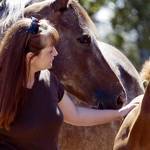Finding the Right Time to Breed Mares

Breeding a mare when she is most fertile is the best way to optimize the chance of pregnancy. Because the mare is at the peak of fertility for only a few hours during each three-week-long reproductive cycle, a series of ultrasound examinations of the ovaries should be done every few days while the mare is in estrus.
The veterinarian will look for ripening follicles on one or both ovaries. When a follicle is found, more frequent ultrasound examinations can be used to pinpoint the time of ovulation. Natural or artificial insemination is most successful if it is performed within a few hours before or after ovulation
Instead of waiting for ovulation to occur naturally, another option is to inject the mare with a commercial hormone preparation as soon as a sufficiently large follicle has been detected by ultrasound. This will usually cause ovulation within the next 36 hours, and natural or artificial insemination can be planned within this time frame. The mare can be examined by ultrasound after insemination to confirm that ovulation has taken place.
Another ultrasound examination two weeks after breeding can determine whether pregnancy has been achieved. If the mare is not pregnant, she will probably be developing another follicle at this point, and the new follicle can be tracked until the next ovulation takes place.
After the mare has been confirmed in foal, she may be checked at about 30 days after breeding, at which point the fetal heartbeat can be detected. Ultrasound examinations at 45 and 60 days can be scheduled to be sure the mare has not lost the pregnancy, an occurrence that is most common during the first two months after conception. If the mare is found not to be pregnant at 60 days, there may be time left in the breeding season to rebreed, especially if the first attempt was made very early in the season. A veterinarian can advise the owner on whether the mare is a good candidate for a second pregnancy and also on the medications that may be helpful in bringing her into heat late in the season.








